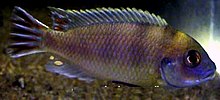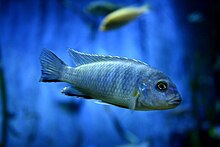Maylandia
| Maylandia | ||||||||||||
|---|---|---|---|---|---|---|---|---|---|---|---|---|

Maylandia greshakei , type species of the genus |
||||||||||||
| Systematics | ||||||||||||
|
||||||||||||
| Scientific name | ||||||||||||
| Maylandia | ||||||||||||
| Meyer & Foerster , 1984 |
Maylandia ( Dedikationsname in honor of Hans J. Mayland, author aquaristischer nonfiction) is one of the most popular genres of the cichlids belonging (Cichlidae) Mbuna . The species of the genus live in nature exclusively in Malawi (in Tanzania and Mozambique Njassasee is called) and the African Great grave breach heard and in Lake Malombe and the Shire River, which connects the two lakes.
features
Maylandia species grow up to about 20 centimeters long, their caudal fin just cut off. They have a moderately steep forehead, a thickening in the bone of the nasal cranial process and a lower jaw with a characteristic angle to the horizontal axis. In addition, all species are characterized by their feeding behavior, in that they press their end mouth against the surface from which they peel off growth . They can be distinguished from species with similar feeding behavior by their different teeth. Male Maylandia in courtship mood are intensely colored, the females of some species have a completely different coloration or there are morphs of them, e.g. B. piebald (so-called OB morphs of 'orange blotched') or solid orange (O morphs). Pied males (so-called 'Marmalade Cats') are extremely rare in nature, while in aquariums they are increased by selection breeding. Both sexes can have egg spots in the anal fin , which are surrounded by a transparent border. In the female animals, the egg spots are usually smaller or less luminous, their number is smaller, they can also be absent. The description of some species is partly not recognized by other authors because they represent different species concepts . Some authors view geographical variants as distinct species that others do not even accept as subspecies.
Reproduction
All Maylandia species are mouthbrooders . The males are polygamous . Before mating, in most species the male prepares a flat stone as a spawning area by cleaning it. With fluttering movements, in which especially the anal fin provided with the egg spots is presented, it advertises the female. According to some authors, the females choose the male that suits them best according to visual criteria (Visual Mate Recognition System). Other authors, however, are of the opinion that the females can distinguish the males they match on the basis of vocalizations. In any case, this usually prevents hybridization and selects aspects of the health fitness of the potential partner and thus the higher probability of good genes. During and immediately after spawning, the female takes the eggs into her mouth, sometimes before fertilization. The eggs in the mouth are only inseminated when the female snaps at the egg spots on the male's anal fin, which ejects sperm in the process. The young hatch after about three weeks and are usually guarded for several days and then taken back into the mouth in the event of danger and at night.
species
Maylandia includes over 30 species:
- Maylandia aurora (Burgess, 1976)
- Maylandia barlowi (Mckaye & Stauffer, 1986)
- Maylandia benetos (Stauffer, Bowers, Kellogg & McKaye, 1997)
- Maylandia callainos (Stauffer & Hert, 1992)
- Maylandia chrysomallos (Stauffer, Bowers, Kellogg & McKaye, 1997)
- Maylandia cyneusmarginata (Stauffer, Bowers, Kellogg & McKaye, 1997)
- Maylandia emmiltos (Stauffer, Bowers, Kellogg & McKaye, 1997) is sometimes viewed as a synonym for M. zebra .
- Maylandia estherae (Konings, 1995)
- Maylandia fainzilberi (Staeck, 1976)
- Maylandia flavicauda Li, Konings & Stauffer, 2016
- Maylandia flavifemina (Konings & Stauffer, 2006)
- Maylandia glaucos (Ciccotto, Konings & Stauffer, 2011)
- Maylandia greshakei (Meyer & Foerster, 1984)
- Maylandia hajomaylandi (Meyer & Schartl, 1984)
- Maylandia koningsi Stauffer, 2018
- Maylandia lanisticola (Burgess, 1976), Syn .: Metriaclima lanisticola , Pseudotropheus lanisticola , is sometimes seen as a synonym for M. livingstonii .
- Maylandia lombardoi (Burgess, 1977)
- Maylandia lundoense (Stauffer et al., 2013)
- Maylandia mbenjii (Stauffer, Bowers, Kellogg & McKaye, 1997)
- Maylandia midomo (Stauffer et al., 2013)
- Maylandia mossambica (Ciccotto, Konings & Stauffer, 2011)
- Maylandia nigrodorsalis (Stauffer et al., 2013)
- Maylandia nkhunguensis (Ciccotto, Konings & Stauffer, 2011)
- Maylandia pambazuko (Stauffer et al., 2013)
- Maylandia phaeos (Stauffer, Bowers, Kellogg & McKaye, 1997)
- Maylandia pulpican (Tawil, 2002)
- Maylandia pursa (Stauffer, 1991) is sometimes viewed as a synonym for M. livingstonii .
- Maylandia pyrsonotos (Stauffer, Bowers, Kellogg & McKaye, 1997) is sometimes viewed as a synonym for M. zebra .
- Maylandia sciasma (Ciccotto, Konings & Stauffer, 2011)
- Maylandia tarakiki (Stauffer et al., 2013)
- Maylandia usisyae Li, Konings & Stauffer, 2016
- Maylandia xanstomachus (Stauffer & Boltz, 1989)
- Maylandia xanthos (Ciccotto, Konings & Stauffer, 2011)
- Maylandia zebra (Boulenger, 1899)
In addition to the recognized species, there are many still undescribed forms that aquarists use under common names such as B. Maylandia sp. "zebra gold" are known.
Taxonomy
The name Maylandia was introduced in 1984 to denote a subgenus of Pseudotropheus , but then through the description of Metriaclima by Stauffer et al. automatically raised to the rank of a genre . In this work, Stauffer and colleagues are of the opinion that Maylandia is not a valid genus ( nomen nudum ) because, in their opinion, the original description does not meet the criteria of the International Commission on Zoological Nomenclature (ICZN) for new taxa . However, this was contradicted by various ichthyologists, they consider Metriaclima to be a more recent synonym of Maylandia . Since then, the camps have been divided, which is also reflected in the Internet. Both Maylandia and Metriaclima can be found on several 10,000 pages. The name Maylandia is currently used in both Fishbase and the Catalog of Fishes .
Individual evidence
- ↑ a b Erwin Schraml: Maylandia. In: Claus Schaefer, Torsten Schröer (Hrsg.): The large lexicon of aquaristics. Eugen Ulmer, Stuttgart 2004, ISBN 3-8001-7497-9 , pp. 618-625.
- ^ A b J. R. Stauffer, Jr., NJ Bowers, KA Kellogg, KR McKaye: A revision of the blue-black 'Pseudotropheus zebra' (Teleostei: Cichlidae) complex from Lake Malawi, Africa, with a description of a new genus and ten new species. In: Proceedings of the Academy of Natural Sciences of Philadelphia. 148, 1997, pp. 189-230. PDF
- ^ HE Paterson: A comment on “mate recognition systems”. In: evolution. 34, 1980, pp. 330-331.
- ↑ MCP Amorim, JM Simes, PJ Fonseca, GF Turner: Species differences in courtship acoustic signals among five Lake Malawi cichlid species ('Pseudotropheus' spp.). In: Journal of Fish Biology. 72, 2008, pp. 1355-1368.
- ↑ a b Maylandia on Fishbase.org (English)
- ↑ a b M. K. Meyer, W. Foerster: Un nouveau 'Pseudotropheus' du lac Malawi avec des remarques sur le complexe 'Pseudotropheus-Melanochromis' (Pisces, Perciformes, Cichlidae). In: Revue française d'Aquariologie Herpetologie. 10 (4), 1984, 1983, pp. 107-112.
- ^ M. Bailey: 'Maylandia' or 'Metriaclima' - the case for 'Metriaclima'. In: eggspots. no. 4, 2010, pp. 39-45.
- ↑ E. Schraml: 'Maylandia' or 'Metriaclima' - still not resolved? In: eggspots. 2, 2009, pp. 5-15. ISSN 1869-2354
- ↑ Maylandia in the Catalog of Fishes (English)








